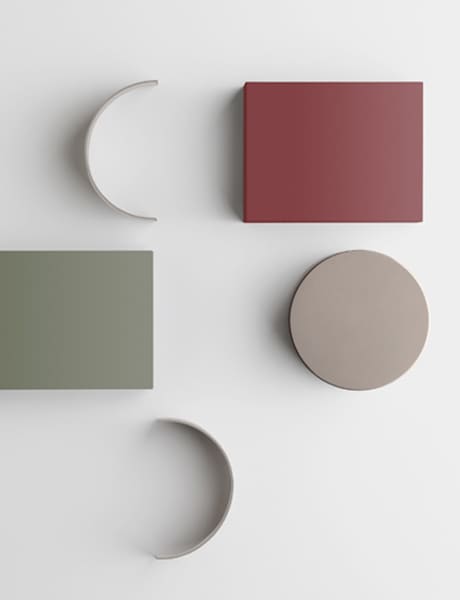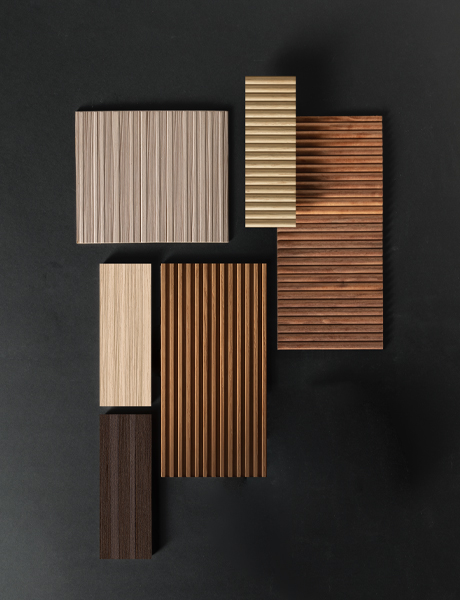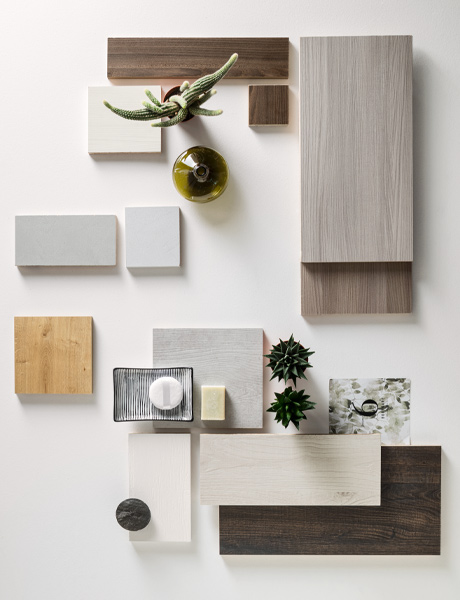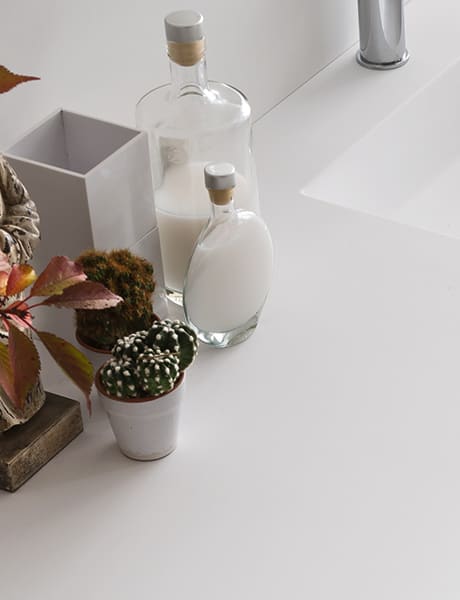To take care of your furniture and keep it looking flawless over time, it is important that you know about the characteristics of the materials it is made from, and use suitable cleaning methods.

Modern
Lacquered surfaces are in all of the shades available in our colour range. All surfaces, from the base units to the tops, and the wall units to the mirrored cupboards, can be lacquered. In addition to a smooth lacquer, you can opt for a wood grain such as oak, or a laminate such as Sherwood, and this too can be lacquered. This creates a relief-effect lacquer, with the textured grain coming through from underneath the paint. The only colour not suitable for lacquering wooden surfaces is Platino, as it is applied using a special technique that cannot be reproduced on uneven surfaces.
Matt and glossy lacquers
Metal colours (only matt version)
Cleaning lacquered surfaces
Lacquered surfaces require particularly careful maintenance to avoid scratches. To clean lacquered surfaces, use glass-cleaning products or alcohol diluted with plenty of water. Dry the surfaces immediately using a soft, non-abrasive cloth. Do not use abrasive powders. Do not use excessively aggressive products such as ammonia or acetone on lacquered surfaces. Avoid furniture wax and direct contact with perfumes or acid-based products. Some colour may rub off onto the cloth the first few times you clean the surfaces. This is physiological and is caused by the paint powders rising to the surface during drying. Once they have been removed, they will not come back.

Natural
Wood-grain surfaces are among the most highly prized, meaning they must be used with care. Wood
is a living material that is particularly sensitive to heat and humidity. Colour changes over time due to light are not to be considered a defect. On the contrary, they are proof that this is a natural material. Wood features unique knots, tiny holes and imperfections on the surface that indicate that it is an authentic material. These irregularities are not to be considered defects but rather an added value. They add to the uniqueness of the finish.
The bark-effect wood is obtained from the core or “heart” of the tree, i.e. the toughest, most solid part of the trunk. It is used to create long-lasting, resistant furniture of exceptionally high quality, without any chemical treatment that would detract from its naturalness.
Cleaning WOODEN surfaces
To clean wooden surfaces, use a damp cloth with a standard glass-cleaning product (e.g. Vetril), or water and Marseille soap. Dry off any drops of water on the wooden tops. Over time, stagnant water can penetrate into the grooves in the wood created during the brushing process and cause the paint to lift. This is due to the increased humidity of the wood. Do not use abrasive products, acetone, chlorine or thinners. Do not use furniture wax or polish, which are not required owing to the special protective treatment on the surfaces, and may damage the paint.
Bark-effect wood: to clean, use warm water (preferably distilled as it has no limescale) and 20%-30% alcohol. Do not use abrasive sponges.

Wood-grain surfaces are among the most highly prized, meaning they must be used with care. Wood
is a living material that is particularly sensitive to heat and humidity. Colour changes over time due to light are not to be considered a defect. On the contrary, they are proof that this is a natural material. Wood features unique knots, tiny holes and imperfections on the surface that indicate that it is an authentic material. These irregularities are not to be considered defects but rather an added value. They add to the uniqueness of the finish.
Cleaning “LAVORATI” surfaces
To clean wooden surfaces, use a damp cloth with a standard glass-cleaning product (e.g. Vetril), or water and Marseille soap. Dry off any drops of water on the wooden tops. Over time, stagnant water can penetrate into the grooves in the wood created during the brushing process and cause the paint to lift. This is due to the increased humidity of the wood. Do not use abrasive products, acetone, chlorine or thinners. Do not use furniture wax or polish, which are not required owing to the special protective treatment on the surfaces, and may damage the paint.

Melamine consists of a coating in melamine paper, applied onto a chipboard or MDF panel impregnated with a melamine resin. Thanks to increasingly realistic paper, Arcom has achieved finishes similar to a wood effect. These characteristics, together with its hard, scratch- and solvent-resistant qualities, make melamine panelling a valid solution that looks and feels great.
Colours
Oak
Sherwood
Elm
Ares
SALE
Cleaning melamine surfaces
Smooth or slightly embossed surfaces: Avoid using spray products directly on the surface as they may leave marks. Apply the detergent on a clean, soft, damp cloth, then rinse. Avoid abrasive products, bleach or strongly chlorinated substances, and strong acids and alkalines.
Embossed surfaces: clean for the first time with a soft cloth using 50% alcohol. For pronounced finishes and very light colours, preliminary cleaning may not be enough to remove dirt from the embossed surface. If this is the case, treat the affected area gently with a melamine foam sponge. Wet the sponge with warm water and wring it out before use. Avoid very abrasive sponges that may polish the surface.

Elegant
Natural marble may differ from the sample in its shading, and may feature small holes, and more or less pronounced veining. These are characteristics of the marble itself and confirm the authentic nature of the product.
Cultured marble is made up of granules, marble powder, cement and polyester resins (5%-8%) with a prevalence of calcium carbonate. Cultured marble is similar to natural marble and therefore requires constant maintenance.
Cleaning marble surfaces
Natural marble: To maintain the marble’s shine, perform adequate and constant maintenance, and avoid excessive use of unsuitable soaps or detergents. We recommend protecting the surfaces with a stain-proof, water-repellent product.
Cultured marble: Cultured marble is similar to natural marble and therefore requires constant maintenance. Use water and a mild detergent to clean these surfaces. Avoid direct contact with cosmetics and aggressive products used for cleaning the washbasin, as these may dull or stain the surface.

Laminam is derived from a mixture of natural raw materials, which are ground together wet, transformed into granulate mix and compacted, before being synthesised at 1200 degrees in hybrid furnaces and then cut into 3 mm thick slabs. This material is resistant to scratches and deep abrasion. This means its properties remain unchanged, even following intensive use and frequent cleaning. Mould, bacteria and fungi cannot grow on this surface. Laminam is free from organic pigments and is resistant to UV rays. The colour is not altered, even if exposed to changes in climatic conditions. This product is 100% natural. It does not release elements into the environment. It can easily be ground down and fully recycled in other production processes.
Cleaning Laminam surfaces
Laminam is very easy to clean and preserve. The only product capable of affecting this material is hydrofluoric acid (anti-rust). Use mild, non-acid-based detergents. Viakal can be used to remove limescale; apply with an abrasive sponge. To remove traces of silicone or stubborn stains, apply Cif cream using an abrasive sponge.

Innovative
Unicolor consists of a chipboard panel clad with a laminate sheet, available in various wood-, stone- and cement-effect finishes. These characteristics, together with its hardness, and scratch- and solvent-resistant qualities, make Unicolor tops a valid solution that looks and feels great.
Cleaning Unicolor surfaces
Avoid using spray products directly on the surface as they may leave marks. Apply the detergent on a soft, clean and damp cloth. Then rinse. Avoid abrasive products, bleach or strongly chlorinated substances, and acids and alkalines.

Unicolor HPL is a thick laminate (10 mm) made up of internal layers of cellulose fibres impregnated with phenolic resins, and outer layers impregnated with thermosetting resins. All the layers undergo resin-polycondensation, which involves high pressure and 150° heat. The surface is rough, but the material is not porous: this stops mould and bacteria from forming. It is resistant to scratches, knocks, abrasion and wear. It is also impermeable, making it highly resistant to chemical and organic agents. This material is dustproof and easy to clean, and withstands temperatures of up to 170°.
Cleaning composite UNICOLOR surfaces
For everyday cleaning, use a mild detergent. Do not use abrasive sponges. For stubborn limescale, use white vinegar. Leave for a maximum of 5 minutes. Rinse thoroughly.

Lightweight
Arcom uses glass both for its washbasins and tops, measuring 1 cm, 1.5 cm and 1.9 cm thick. Curved glass washbasins are created by melting glass over a mould which is then placed in a furnace. Once cooled, the washbasin is processed, squared, drilled, and sandblasted and painted where applicable. From this fusion, we obtain a highly resistant, high-quality glass. Avoid: knocks, falling blunt objects, and thermal shocks of more than 40°.
Colored glasses
Glass and Mirror (available on front only – Shape collection)
Cleaning glass AND MIRROR surfaces
For routine cleaning, Arcom recommends mild, non-aggressive, alkaline detergents or warm water. Do not use detergents with solvents or abrasives.

Versatile
Teknorit is a compound of resin, mineral fillers and pigments which, when combined, create a solid, non-porous, uniform product that is renewable, light and more resistant than stone. Tops made from this material performed very well in two important “resistance” tests: 1. high resistance to stains, which is extremely important for products used both in the kitchen and bathroom. 2. resistance to thermal shocks, i.e. resistance to breakage in the event of alternating temperature changes (hot water\/cold water).
Cleaning Teknorit surfaces
Clean washbasins with powdered abrasive products, Scotch-Brite or thin sandpaper.

Bianco opaco: Teknoril is 100% made up of extremely high-quality natural minerals and acrylic polymers (ATH-MMA). The material is as smooth and compact as stone, untreated with paint, fireproof, and easy to clean with any mild bathroom cleaning product.
Glossy Bianco: Teknoril is a compound of natural mineral fillers and a polyester resin that is coated with a surface film in acrylic resin/polyester. This gives it excellent chemical and physical resistance properties (glossy finish).
Matt colour: Coloured Teknoril is 100% made up of extremely high-quality natural minerals and acrylic polymers (ATH-MMA). The material is smooth and/or has a stone effect and comes in different colours. The colours are uniform within the internal thickness of the solid mass.
Teknoril – Smooth
Teknoril – stone-effect
Cleaning TEKNORIL
Matt White: Teknoril can be cleaned with lukewarm water and a mild detergent. Use a soft cloth or sponge. Then dry with a soft cloth. For limescale stains, use a descaler (e.g. Viakal, Ajax or Cif). Rinse with lukewarm water and a soft cloth, then dry.
Glossy White: Glossy white Teknoril can be cleaned with warm water and neutral detergent using a soft cloth and then dried. Do not use acid-based products.
Matt colour: Coloured Teknoril can be cleaned with lukewarm water and a mild detergent using a soft cloth. Then dry. For limescale, use a descaler (e.g. Viakal, Ajax or Cif). Rinse with lukewarm water.

Mineralguss is a composite made up of natural mineral fillers (calcium carbonates and aluminium trihydrates) bound to a low percentage of polyester resin. It is not a plastic material, but rather a mineral compound that is elegant to touch, hygienic, and suitable for a bathroom or public areas. The gelcoat film covering the material surface provides excellent physical resistance and exceptional chemical resistance.
Cleaning Mineralguss
To clean Mineralguss, use soapy water or any common non-abrasive detergent with a non-abrasive sponge or cotton cloth. Rinse thoroughly.

Resistant
Mineral composite shower tray with a resin film that covers the surface and edges, for excellent physical and chemical resistance.
Tekor Mud
Tekor Pietra
Cleaning Tekor
To remove most stains, limescale and dirt that are normally deposited on the surface, clean with soapy water or any common non-abrasive detergent and a soft-bristled brush. Rinse thoroughly. For stubborn dirt like limescale, use white vinegar or lemon with a soft-bristled brush. Rinse with water.
Subscribe to our newsletter
Subscribe to our newsletter to receive the latest news and updates